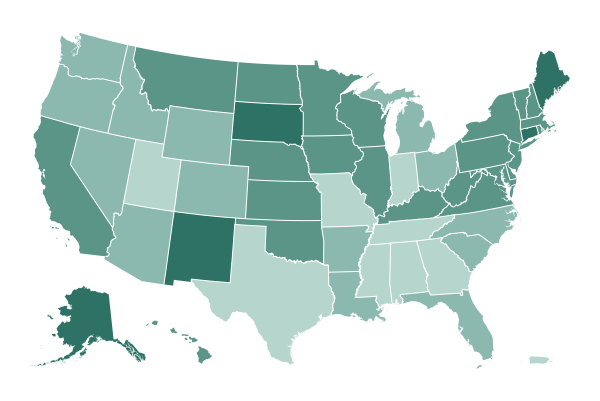The coronavirus most likely emerged in bats before spreading to humans through another animal, according to a report to be released by the World Health Organization on Tuesday, offering some clues on a question that has become politically fraught amid accusations of interference from Beijing.
According to the report on the origin of the pandemic, which was obtained by The New York Times in advance of its release, a team of experts who recently visited the Chinese city of Wuhan, where the coronavirus was first detected in late 2019, also dismissed the idea that the virus might have leaked accidentally from a Chinese laboratory as “extremely unlikely.”
Officials in the United States and elsewhere have expressed concern about China’s efforts to reshape the narrative about the outbreak in Wuhan, which the authorities initially tried to conceal.
Critics have assailed the inquiry by the W.H.O. team as insufficient, saying the global health agency has been too deferential to Beijing. Chinese scientists, many of whom are affiliated with the government, helped oversee the inquiry, and the report was repeatedly delayed amid delicate negotiations with Chinese officials. For months, China sought to delay the visit of the investigators in an apparent attempt to avoid scrutiny of its early mistakes in handling the pandemic.
The Chinese government has defended its approach, saying it is fully cooperating with the W.H.O.
In the 123-page report, the scientists outlined several theories that might explain how the virus first spread to humans. The findings in the document were first reported on Monday by The Associated Press.
The report was written jointly by a team of 17 scientists from around the world and 17 Chinese scientists. The experts led a fact-finding visit to Wuhan for 27 days in January and February.
During the visit to Wuhan, Chinese officials refused to share raw data about some of the earliest possible virus cases with the W.H.O. team, frustrating some of the visiting scientists.
China’s lack of transparency as well as other concerns prompted a small group of scientists not affiliated with the World Health Organization to call this month for a new inquiry into the origin of the pandemic. They said such an inquiry should consider the possibility that the virus escaped from a laboratory in Wuhan or infected someone inside it.
The lab leak theory has been promoted by some officials in the Trump administration, including Dr. Robert Redfield, the former director of the Centers for Disease Control and Prevention, in comments to CNN last week. He offered no evidence and emphasized that it was his opinion; the theory has been widely dismissed by scientists and U.S. intelligence officials.
Matt Apuzzo contributed reporting.
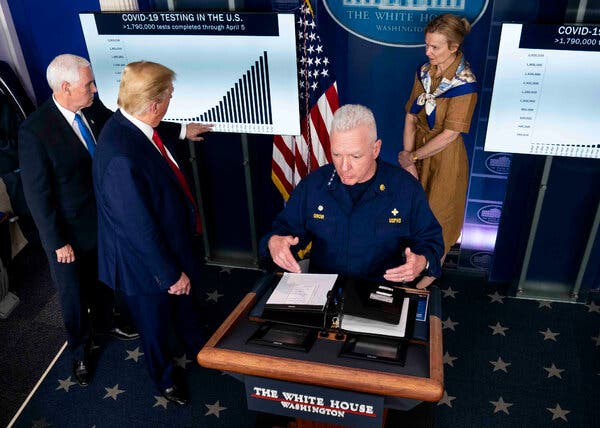
In interviews broadcast on CNN Sunday night, former President Donald J. Trump’s pandemic officials confirmed in stark and no uncertain terms what was already an open secret in Washington: The administration’s pandemic response was riddled with dysfunction, and the discord, untruths and infighting most likely cost many lives.
Dr. Deborah L. Birx, Mr. Trump’s coronavirus response coordinator, suggested that hundreds of thousands of Americans may have died needlessly, and Adm. Brett P. Giroir, the testing czar, said the administration had lied to the public about the availability of testing.
The comments were among a string of bombshells that emerged during a CNN special report that featured the doctors who led the government’s coronavirus response in 2020.
Dr. Robert R. Redfield, the former director of the Centers for Disease Control and Prevention, accused Mr. Trump’s health secretary, Alex M. Azar III, and the secretary’s leadership team of pressuring him to revise scientific reports. “Now he may deny that, but it’s true,” Dr. Redfield said in an interview with Dr. Sanjay Gupta, CNN’s chief medical correspondent. Mr. Azar, in a statement, denied it.
Dr. Stephen K. Hahn, the former commissioner of the Food and Drug Administration, said his relationship with Mr. Azar had grown “strained” after the health secretary revoked the agency’s power to regulate coronavirus tests. “That was a line in the sand for me,” Dr. Hahn said. When Dr. Gupta asked him if Mr. Azar had screamed at him, Dr. Hahn replied: “You should ask him that question.”
But it was Dr. Birx, who has been pilloried for praising Mr. Trump as being “so attentive to the scientific literature” and for not publicly correcting the president as he made outlandish claims about unproven therapies, whose disclosures may have been the most compelling.
As of Sunday, more than 548,000 Americans have died from infection with the coronavirus. “I look at it this way,” she said. “The first time, we have an excuse. There were about 100,000 deaths that came from that original surge.”
“All of the rest of them,” she said, referring to almost 450,000 deaths, “in my mind, could have been mitigated or decreased substantially” had the administration acted more aggressively.
In what was one of her first televised interviews since leaving the White House in January, she also described a “very uncomfortable, very direct and very difficult” phone call with Mr. Trump after she spoke out about the dangers of the virus last summer. “Everybody in the White House was upset with that interview,” she said.
After that, she decided to travel the country to talk to state and local leaders about masks and social distancing and other public health measures that the president didn’t want her to explain to the American public from the White House podium.
Dr. Gupta asked if she was being censored. “Clearly someone was blocking me from doing it,” she said. “My understanding was I could not be national because the president might see it.”
Several of the officials, including Dr. Anthony S. Fauci — who unlike the others is a career scientist and is now advising President Biden — blamed China, where the virus was first detected, for not being open enough with the United States. And several, including Dr. Redfield and Admiral Giroir, said early stumbles with testing — and the attitude within the White House that testing made the president look bad by driving up the number of case reports — were a serious problem in the administration’s response.
And the problems with testing went beyond simply Mr. Trump’s obsession with optics. Admiral Giroir said that the administration simply did not have as many tests as top officials claimed at the time.
“When we said there were millions of tests — there weren’t, right?” he said. “There were components of the test available but not the full deal.”
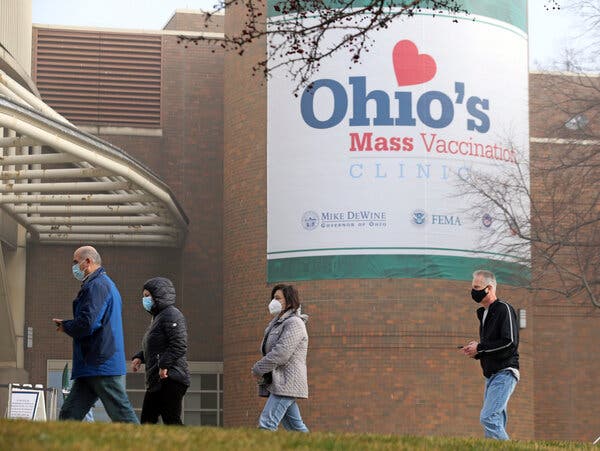
Chris Adams, 36, has spent the past year of the pandemic living with his grandparents in Wichita, Kan., and being “extremely strict” about social distancing. “I never went out,” he said.
But starting Monday, when all adults in Kansas become eligible for the coronavirus vaccine, Mr. Adams plans to find a vaccination site where there is an available appointment. “What I’m looking forward to is seeing my friends again,” he said.
Kansas is one of six states — Louisiana, North Dakota, Ohio, Oklahoma and Texas are the others — that are expanding eligibility for the vaccine to all adults on Monday. Minnesota will follow on Tuesday, and Indiana and South Carolina on Wednesday.
Gov. Laura Kelly of Kansas urged residents last week to seek out appointments, saying, “With the anticipated increase in supply from the federal government, we must get every dose of vaccine into arms quickly.”
Even as vaccine eligibility continues to expand across America — nearly all states have pledged to make every adult eligible by May 1 — the United States has also reported an increase in new cases over the past week. About 75,000 new cases were reported on Friday, a significant increase from the 60,000 added the Friday before.
States in the Northeast have accounted for about 30 percent of the nation’s new cases over the past two weeks, up from 20 percent in the first couple of weeks in February.
In New York, there has been an average of 8,426 new cases a day, an 18 percent increase from the average two weeks earlier, according to a New York Times database. In New Jersey over the past week, there have been an average of 4,249 new cases reported daily, a 21 percent increase from the average two weeks earlier. And on Friday, Vermont set a single-day case record with 283 new infections; it is the first state to set a case record since Jan. 18.
For many, the vaccine cannot come soon enough.
Nicole Drum, 42, a writer in the Kansas City, Kan., metro area, cried on Friday when she found out that she would be eligible to get the vaccine as early as Monday. She started calling pharmacies and looking online for available appointments “within minutes of the news breaking,” she said.
Ms. Drum called about 10 places without success. She had more luck on a county website, and booked an appointment for Wednesday.
She said she planned to wear a special T-shirt saying “I believe in science” to her appointment. “I got myself a fun I’m-getting-the-vaccine outfit,” she said, laughing.
She also plans to take her 4-year-old son with her, because she wants him to see “how research and science and people coming together can really help stem these kinds of things,” she said.
“I want him to know that there’s no need to be afraid all the time of big scary things, because there are always helpers trying to figure this out,” Ms. Drum said. “While the solution might be something that’s a jab in the arm that hurts a little bit, it’s worth it.”
GLOBAL ROUNDUP
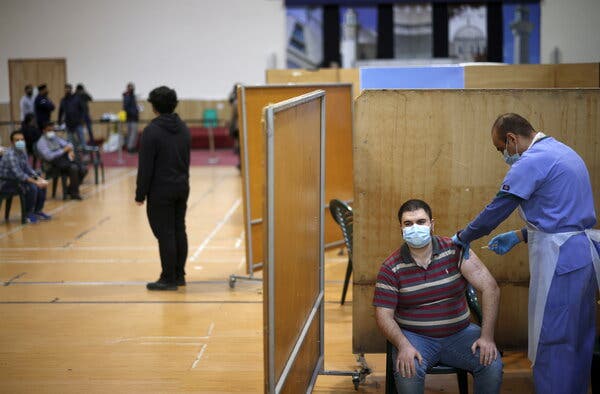
Britain, which has now given a first dose of the coronavirus vaccine to more than 30 million people, began a gradual lifting of coronavirus restrictions for most of its population on Monday.
People in England are now allowed to gather outdoors in groups of up to six, or two households, after the end of a stay-at-home order in force since early January.
Outdoor sports facilities, like tennis and basketball courts and swimming pools, are also opening in England. Nonessential retail and outdoor dining are set to return from April 12. Students returned to classes earlier this month. Elsewhere in Britain, Scotland and Wales have also begun easing stay-at-home orders, and Northern Ireland is set to review on coronavirus restrictions next month.
For many in Britain, the easing was a cautious optimistic note after months lockdown, the nation’s third. The current lockdown began in January, after a new variant of the coronavirus swept the country, with as many as 60,000 daily cases and 1,800 daily deaths at its winter peak. On Sunday, the country reported 3,862 cases and 19 deaths, according to a New York Times database. London has so far reported no deaths from the virus on Sunday, according to Public Health England. If no reports are added later — the figures are not yet finalized — it would be the capital’s first day without a virus death since September. Officials are hoping a slow lifting will largely remove restrictions on socializing in England by June 21.
Travel abroad for English residents, however, remains banned, with a task force reviewing the rule next month. Officials cautioned that people should still work from home where possible and minimize contact.
In other news from around the globe:
-
In Australia, the city of Brisbane announced a three-day lockdown after seven people were infected with the coronavirus, the country’s first citywide lockdown in more than a month. Starting at 5 p.m. on Monday, residents of the city, which is Australia’s third largest, will be allowed to leave their houses only for essential purposes such as buying groceries, exercising or seeking medical care, and masks will be mandatory in public. Tests showed the virus spreading in Brisbane is the highly contagious variant first detected in Britain, officials said.
-
The capital region of the Philippines entered the country’s highest level of lockdown on Monday. Under what is known as enhanced community quarantine, which is set to last until Easter Sunday, Manila and four surrounding provinces are under curfew from 6 p.m. to 5 a.m. People under 18 and over 60, as well as pregnant women and those with chronic health conditions, are instructed to stay home at all times. The capital region, which is home to more than 25 million people, had been on the second-highest level of lockdown since March 22.
Yan Zhuang and Jennifer Jett contributed reporting.
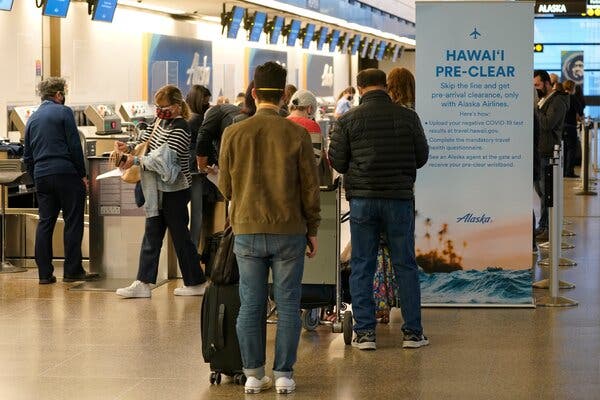
Palakiko Chandler took their little cousins to Nanakuli Beach on Oahu last weekend and noticed something they hadn’t seen in a while: a parking lot full of rental cars. The tourists were back.
“It was just so packed,” said Mr. Chandler, 27 and a Native Hawaiian. “Me and my cousins were looking at each other like, should we just go home?” The youngest cousins needed several reminders to keep their distance from strangers for virus safety.
For much of the pandemic, Hawaii had some of the strictest rules for visitors in the United States, requiring a 14-day quarantine for everyone arriving in the islands. The policy took a heavy economic toll on a state that depends heavily on tourism, but it was lauded for its success in limiting the impact of the virus for months.
Now, though, Hawaii has reopened for travelers: A negative test within 72 hours of arrival lets them skip the quarantine in most places. At least 28,000 people arrived in Hawaii on each of the last two Saturdays, according to state travel data — the most in a day since the pandemic began, and not far from typical prepandemic levels.
The influx has residents worried. Some have been posting on social media for months, pleading with mainlanders not to come, or if they do, to be mindful of the islands’ isolation and limited resources. The state has a total of 3,000 hospital beds for its population of 1.4 million, and has among the fewest I.C.U. beds per capita of any state; they were often mostly full even before the pandemic.
Hawaii’s precautions did not keep the virus out completely: The islands had a holiday surge, like the rest of the country, and parts of the state are struggling with outbreaks now. Daily new case reports have doubled since late February, with some recent clusters focused on tourism workers. Hospitalizations have increased 17 percent in the last two weeks.
“The looming concerning things are the variants,” said Dr. Damien Kapono Chong-Hanssen of the Kauai Community Health Center. “The California variant has been implicated in what’s happening in Maui right now. Maui is not looking better.”
Mainlanders are making the trip anyway. “Hawaii is again packed with tourists,” wrote the travel site The Points Guy. Favorite sites are sold out, check-in lines are long, and the lines for outbound flights are getting longer.
Tourists are crowding popular beaches without wearing masks or paying much attention to social distancing. Some visitors have gotten rowdy. A pair of arriving tourists were sent home after trying to pay a bribe to avoid the testing requirement.
The situation is worsening the irritation that many state residents feel toward vacationers. Now the tourists aren’t just crowding the island and driving up prices, they say, they are also heedlessly risking everyone’s health.
“Hawaiians and locals alike have always seen the disrespect that tourists bring to our islands,” Mr. Chandler said. “This is kind of the last straw. You’re coming to our home and you’re endangering us during a pandemic.”
The tension is especially prevalent among Native Hawaiians and Pacific Islanders, who face greater risk for Covid-19 and higher rates of chronic disease than average.
“Local people are tired of being treated a certain type of way,” said Charles Kaua Taylor-Fulton, 20, who lives on Oahu. “When tourists come, they can be very rude or entitled. There’s just a sense of entitlement.”
Dr. Lee Buenconsejo-Lum of the University of Hawaii at Manoa said the state’s case numbers are not exploding, at least not yet. But she said she would like to see travelers exhibit the same commitment to wearing masks that locals have. “It’s a matter of constantly educating the tourists,” she said.
Still, the high travel season is just getting started, and restrictions are continuing to ease. Bars have reopened in parts of the state and outdoor weddings are now allowed to welcome up to 100 guests.
“We can already see into the future of summer,” Mr. Chandler said, “and it’s going to be packed.”
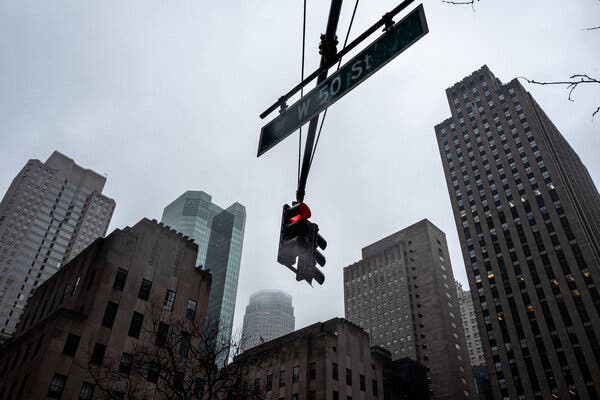
A year after the coronavirus spurred an extraordinary exodus of workers from New York City office buildings, what had seemed like a short-term inconvenience is now becoming a permanent shift in how and where people work. Employers and employees have both embraced the advantages of remote work, including lower office costs and greater flexibility for employees, especially those with families.
Beyond New York, some of the country’s largest cities have yet to see a substantial return of employees, even where there have been less stringent lockdowns, and some companies have announced that they are not going to have all workers come back all the time.
In recent weeks, major corporations, including Ford in Michigan and Target in Minnesota, have said they are giving up significant office space, while Salesforce, whose headquarters occupies the tallest building in San Francisco, said only a small fraction of its employees would be in the office full time.
But no city in the United States, and perhaps the world, must reckon with this transformation more than New York, and in particular Manhattan, an island whose economy has been sustained, from the corner hot dog vendor to Broadway theaters, by more than 1.6 million daily commuters.
About 90 percent of Manhattan office workers are working remotely, a rate that has remained unchanged for months, according to a recent survey of major employers by the Partnership for New York City, which estimated that less than half of office workers would return by September.
Across Midtown and Lower Manhattan, the country’s two largest central business districts, there has never been a greater proportion of office space for lease — 16.4 percent, much higher than in past crises, including after the Sept. 11 terror attacks in 2001 and the Great Recession in 2008.
As more companies push back dates for returning to offices and make at least some remote work a permanent policy, the consequences for New York could be far-reaching, not just for the city’s restaurants, coffee shops and other small businesses, but for municipal finances, which depend heavily on commercial real estate.
Some of the largest and most enduring companies, including JPMorgan Chase & Co., which has more than 20,000 office employees in the city, have told their work forces that the five-day office workweek is a relic. The bank is considering a model in which employees would rotate between working remotely and in the office.
Other large businesses, including the accounting firm PricewaterhouseCoopers, the marketing group Omnicom Group and the advertising giant WPP, have searched for subtenants to take over significant chunks of their Manhattan offices.
The loss of workers has caused the market value of commercial properties that include office buildings to plunge nearly 16 percent, prompting a sharp decline in the tax revenue that pays for essential city services.
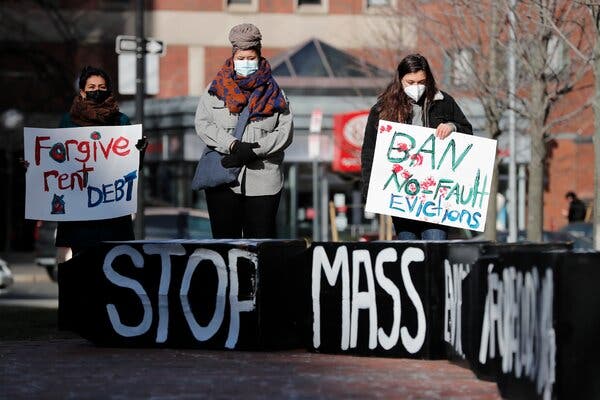
The Centers for Disease Control and Prevention has extended its nationwide moratorium on evictions through June 30, pushing it back from the end of March, when it had been scheduled to lapse.
The move, while widely expected, comes at a precarious moment in the pandemic as the increasing vaccine availability accelerates reopening plans by businesses and local governments — even as millions of families continue to struggle with hardships that might have led to mass evictions.
The C.D.C. issued the moratorium last fall, citing its jurisdictional authority to implement measures needed to promote public health, and agency officials cited those same powers in extending the moratorium on Monday.
“The Covid-19 pandemic has presented a historic threat to the nation’s public health,” the agency’s director, Rochelle P. Walensky, said in a statement. “Keeping people in their homes and out of crowded or congregate settings — like homeless shelters — by preventing evictions is a key step in helping to stop the spread.”
Under Mr. Biden, the Department of Housing and Urban Development earlier this year extended its own moratorium on federally financed housing to June 30. (A previous version of this item misstated the status of that moratorium. It was extended in February.)
The new housing secretary, Marcia L. Fudge, has signaled she would like to extend her agency’s eviction freeze even longer. Department officials have reached out to community groups to elicit suggestions on how to streamline the new rule.
The administration’s $1.9 trillion relief package, passed earlier this month, includes $21.5 billion for emergency rental assistance, $5 billion in emergency housing vouchers, $5 billion for homelessness assistance and $850 million for tribal and rural housing. But that aid will take months to be disbursed.
Initially, the C.D.C. ban was riddled with loopholes that allowed some landlords to evict some tenants. But overall, it helped to create a significant drop in eviction applications filed in the local housing courts.
The federal moratorium is part of a patchwork of federal, state and local efforts to prevent a national health and economic emergency from turning into a monumental housing collapse.
Most states — 43 in all, plus Washington, D.C. — have temporarily halted evictions during the crisis. But the range of protections varies wildly and some tenants, including in the New York City neighborhoods hit hardest by Covid, have been displaced because they were unaware of the protections.
As many as one in five renters said they did not pay last month’s rent, according to Census Bureau surveys, with a third of Black renters reporting a recent missed payment.
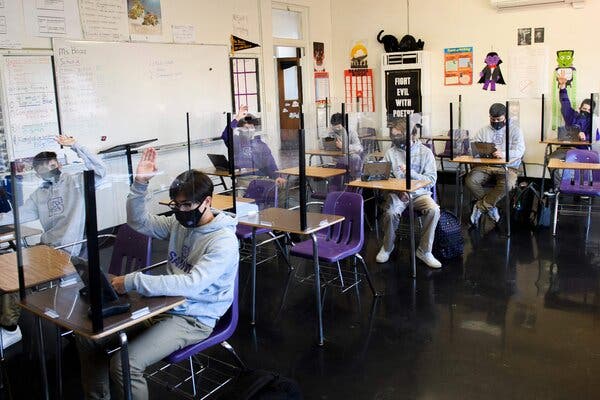
California continued its uneven progress in reopening schools on Monday, as elementary students began to return to classrooms in Long Beach, the state’s fourth-largest district with 70,000 students.
Public schools in the state’s top three districts by enrollment — Los Angeles, San Diego and Fresno — have said they will begin to allow grade-school students back onto campus later in April, as new coronavirus cases have fallen sharply across California.
Schools in Oakland and San Francisco also are scheduled to reopen next month for elementary and special-needs students. But labor agreements in both cities have allowed substantial numbers of teachers to opt out, leaving some schools without enough teachers to reopen and prompting others to scramble for substitutes.
Although many smaller California districts have been open for months, large urban districts on the West Coast generally have lagged behind their counterparts in the rest of the nation. Surging infections in Southern California after the winter holiday were partly to blame for a slow rebound in the Los Angeles school system.
Teachers’ unions generally are more powerful in Democratic-led Washington, Oregon and California than in many other states, and teachers have been wary of returning to what they regard as a hazardous workplace, despite federal guidance that elementary schools in particular are safe when health precautions are followed.
The Long Beach school district has been able to open earlier than other large California school systems because labor unions there agreed last summer to reopen as soon as health conditions permitted, and because the city was able to start vaccinating teachers earlier than other districts in the state.
Unlike most other cities in Los Angeles County, Long Beach has its own public health department, giving the city its own vaccine supplies and the power to set its own vaccine priorities, at a time when the county as a whole was making teachers wait until after other groups, like residents 65 and older, were vaccinated.
“A city with its own health department has the ability to be more nimble,” said Jill Baker, the city’s schools superintendent, who called the return to classrooms this week “exciting and momentous.”
The school district is among the city’s largest employers, and two-thirds of its students qualify for free or reduced-price lunches, so vaccinating school employees and reopening classrooms was viewed as economically important, Ms. Baker said.
About 14,000 students in Long Beach from transitional kindergarten through fifth grade will return this week to school buildings for masked, sanitized and socially distanced instruction. They will be on a hybrid schedule, with students spending about 2½ hours at school each day, five days a week, and completing the school day with remote instruction.
In-person classes for older students are scheduled to resume April 19, with grades 6 to 8 getting the option to return on April 20 and grades 9 to 11 on April 26. The last day of school will be in mid-June.
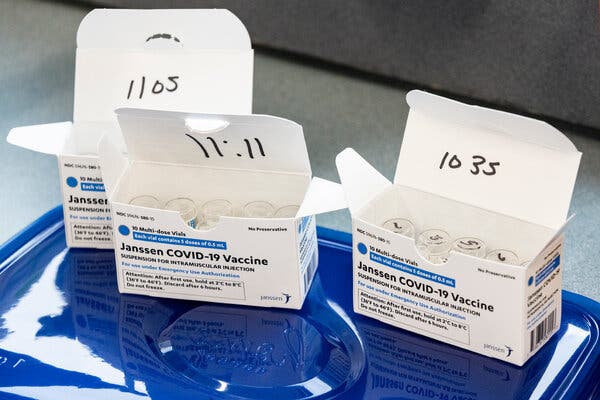
Johnson & Johnson said on Monday that it would supply its one-shot vaccine to African Union member states, as the continent experiences a slow rollout of vaccines, an uptick in cases and worries about new virus mutations.
The pharmaceutical company said that its unit, Janssen Pharmaceutica NV, agreed a deal with the African Vaccine Acquisition Trust, an African Union organization, to supply up to 220 million doses of its Covid-19 vaccine beginning in the fall. The organization will also have the possibility of ordering an additional 180 million doses for a combined total of up to 400 million doses through 2022.
The company will supply most of the doses from a plant in South Africa, which is operated by Aspen Pharma. The African Export-Import Bank, a Pan-African bank headquartered in Cairo, will pay manufacturers $2 billion on behalf of member countries in the form of loans.
South Africa’s president, Cyril Ramaphosa, who as the chair of the African Union set up the vaccine trust last year, is expected to tour the Aspen Pharma facilities in Port Elizabeth, on country’s southeast coast, on Monday.
“This agreement is a significant milestone in protecting the health of all Africans,” Mr. Ramaphosa said in a statement. “It is also a powerful demonstration of African unity and of what we can achieve through partnership between the state sector, the private sector and international institutions that puts people first.”
The announcement came as coronavirus cases surpassed 4.1 million in Africa, with more than 111,000 deaths, according to the Africa Centers for Disease Control and Prevention. Concerns have been mounting about the emergence of variants on the continent, particularly in countries like South Africa, where a highly transmissible variant has driven up cases. Scientists also recently said they found a highly mutated variant of the coronavirus in travelers from Tanzania, the East African nation whose leaders have consistently brushed aside the threat of the coronavirus pandemic.
Besides dealing with other deadly outbreaks including Ebola, polio and measles, many nations in Africa are also dealing with vaccine inequity, as developed nations hoard doses and seek to inoculate their entire populations. So far, only 7.7 million vaccines have been administered on the continent, according to the World Health Organization, which last week warned of a slowdown in deliveries even as initial batches were exhausted.
Vaccines were yet to arrive in 10 African countries, the W.H.O. said, while many others continued to face logistical challenges in addition to vaccine hesitancy.
Nations including South Africa have called on governments and pharmaceutical companies to waive vaccine patents to get medicines to more people more quickly.
The Africa C.D.C. has said that a minimum 60 percent of the continent’s population — or 750 million people — must be vaccinated if the virus is to be curbed there. The deal with Johnson & Johnson “enables Africa to meet almost 50 percent of that target,” Dr. John Nkengasong, the head of the Africa C.D.C., said in a statement.
“The key to this particular vaccine is that it is a single-shot vaccine, which makes it easier to roll out quickly and effectively, thus saving lives,” he added.
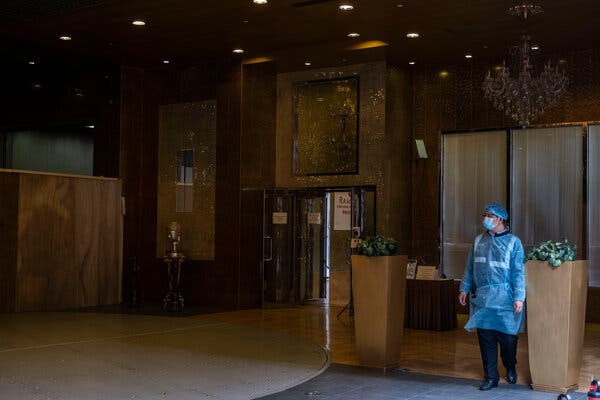
Hong Kong officials said Monday that residents stranded in Britain would be allowed to return starting next month, as they announced the easing of multiple coronavirus restrictions.
Hundreds of Hong Kong residents have been stuck in Britain since late December, when the Chinese territory abruptly announced a ban on direct travel from the country after the emergence there of a highly contagious variant of the virus. Starting in the second half of April, they will be allowed to return to Hong Kong on designated flights, officials said. They did not mention any change to similar bans on arrivals from Brazil, Ireland and South Africa.
Hong Kong’s quarantine requirements, which are among the strictest in the world, will also be eased for travelers arriving from “low-risk” countries like Australia, New Zealand and Singapore. Instead of quarantining at designated hotels for 21 days, they will only have to quarantine there for 14 days followed by seven days of self-monitoring. The Hong Kong border remains closed to nonresidents.
Other changes appeared aimed at rejuvenating the city’s struggling vaccination effort. The government announced that it would lift visitation restrictions at hospitals and nursing homes for those who have been inoculated and end mandatory coronavirus testing for restaurant, school and construction workers who are fully vaccinated.
Only 6 percent of Hong Kong’s 7.5 million people have been vaccinated since the campaign began in February. The program suffered a setback last week when packaging defects were discovered in a batch of doses of the Pfizer-BioNTech vaccine, prompting health officials to suspend its use.
Over the weekend, Hong Kong said that a preliminary investigation by BioNTech of Germany and Fosun Pharma — the Chinese company responsible for distributing the vaccine in Hong Kong — found no systematic problems in its shipments. Health officials said that the vaccine remained safe to use and that they would resume administering it “as soon as possible.”
Aside from the Pfizer-BioNTech vaccine, the only other vaccine authorized for use in Hong Kong is the one developed by the Chinese company Sinovac. Polls have shown that the majority of Hong Kong residents are reluctant to take any vaccine, but they are especially wary of Sinovac after reports that several people had died after receiving it. Officials have found no direct link between the shots and the deaths.
The loosening of restrictions comes as Hong Kong is emerging from a fourth wave of infections that began in late November. For two days over the weekend, the city reported zero local cases for the first time in more than four months. On Monday, one local case was reported.
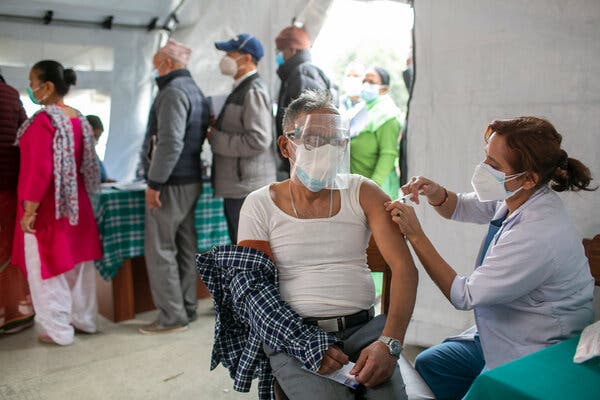
KATHMANDU, Nepal — Nepal on Monday received a donation of 800,000 doses of a Covid-19 vaccine from China, which the authorities said would help them restart an inoculation drive that had been halted because of shipment delays in India.
Dr. Jageshwor Gautam, a spokesman for the ministry of health, said the vaccination campaign could resume in less than a week, “once we determine beneficiary age groups.”
China and India, both of which border Nepal, have been jockeying for influence over the Himalayan nation of 30 million people, most recently through vaccine diplomacy.
Nepal had planned its vaccination campaign around the Oxford-AstraZeneca vaccine manufactured by the Serum Institute of India, the world’s largest vaccine producer. One million doses have been donated by the Indian government, and Nepal had bought an additional two million doses from the Serum Institute.
But half of the purchase from the Serum Institute has been delayed indefinitely, health officials in Nepal said, despite an agreement that it would arrive 15 days after the deal. India, which is supplying the AstraZeneca vaccine to more than 70 countries, has begun holding back nearly all of its exports as it tries to suppress a surge in coronavirus cases at home.
Officials in Nepal suspended vaccinations on March 17, citing the shortage of doses.
To fill the gap, they are now relying on a vaccine developed by the Chinese company Sinopharm, which last month became the second approved for emergency use in Nepal after Beijing pledged to provide doses free.
Since its vaccination drive began in late January, Nepal has administered about 1.6 million doses, according to a New York Times database. Dr. Gautam said the 500,000 remaining AstraZeneca doses would be given to frontline health workers, and that there were none available for the rest of the population “at least for now.”
Nepal has recorded almost 277,000 infections and 3,027 deaths, according to a New York Times database. Although the country’s average daily new cases are a small fraction of what they were at their peak last fall, health officials fear a second wave as infections surge in neighboring India. On Monday, India reported 68,020 new infections, the highest one-day rise since October.



